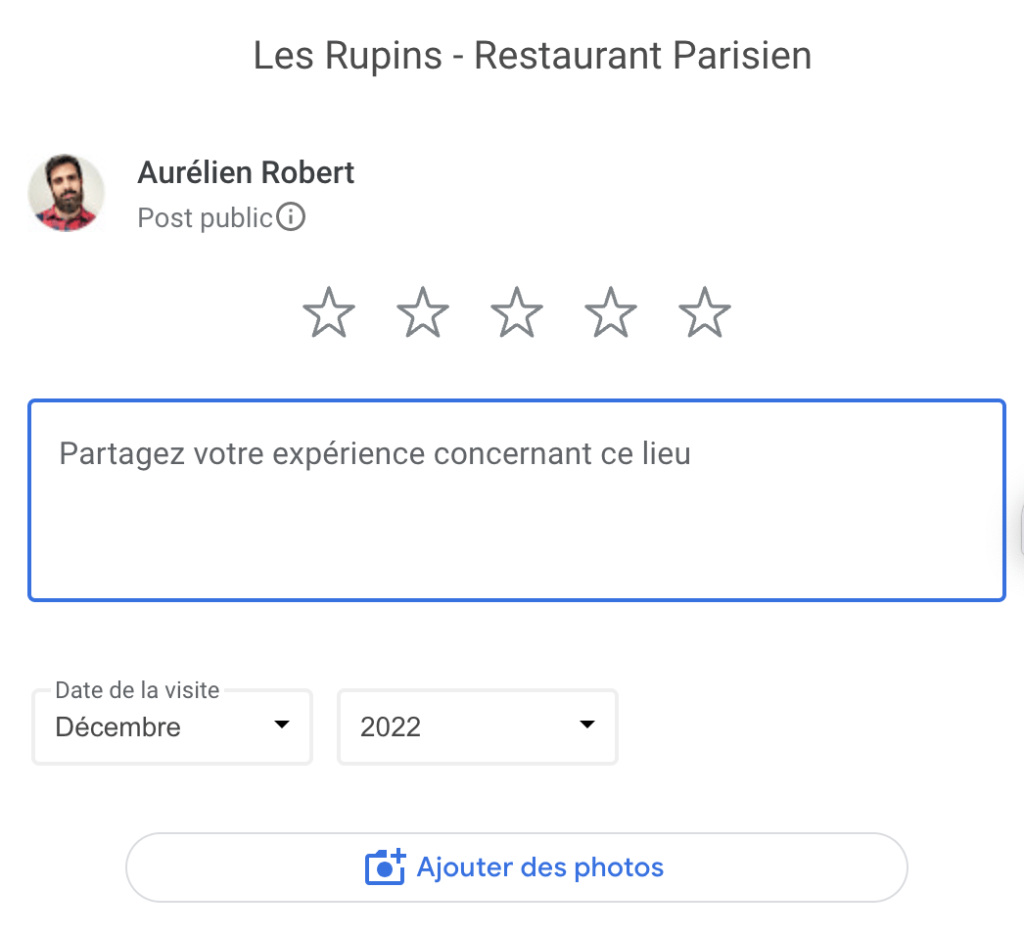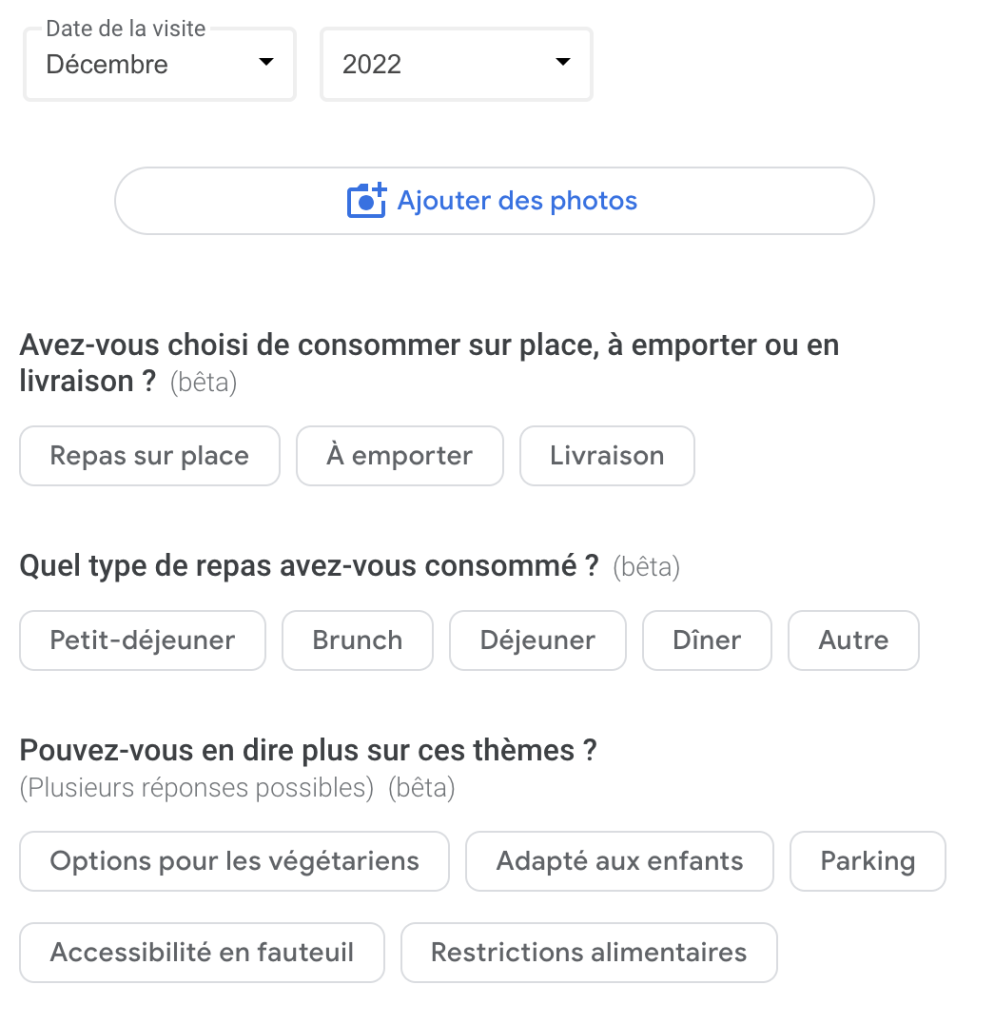Google Maps: Big novelty for restaurant customer reviews, you know everything about MAPS: how do you work on Google Maps
All about Maps: how do you work on Google Maps
● The Google account that causes the opinion has a history of suspicious behavior?
Google Maps: Big novelty for restaurant customer reviews

Aurélien Robert

Written by Aurélien Robert
Google does not lose the pace and continues to test new features at the end of the year.
The latest: adding new additional fields (in beta version) to the customer review form. For the moment, this seems to be particularly concerned the restaurants.
We explain what changes and what it involves in this article.
What changes ?
So far, your customers had access to the following fields when they wanted to leave you an opinion:
- Choose a number of stars
- Write the comment
- Indicate the date of the visit
- Add pictures

From now on, this form also includes:
- Services: your customer has consumed on site, in delivery, to take away ..
- The type of meal consumed: breakfast, lunch, brunch, dinner
- Attributes: vegetarian, adapted to children, accessible in wheelchair, available parking ..
- Prices: customers can indicate the average price they have spent per person

You just have to click to select the desired options. After choosing an attribute, it is even possible to comment it. That is to say to evoke the fact that, for example, this restaurant is vegetarian in a dedicated field.
Our opinion
With these additions, Google sets the first milestones to bring customer reviews into a new dimension.
They are not as complete and exhaustive as a satisfaction survey, but it could be a first step in this direction. Is that the vocation that Google wants to give to opinions ? Will they replace surveys one day ? The future developments developed by the web giant will tell us.
In any case, it is a good way to improve the experience of Internet users, which seems to be one of the priorities of the moment. The comments are more structured and legible than before. The new options also make writing more intuitive. This could increase the level of engagement of those who submit opinions.
Tomorrow, you may be able to personalize the available fields even more in the form of your customer reviews. Or the questionnaire could be different depending on the main category of establishments. There is no shortage of possibilities ..
This is good news for restaurateurs who should receive more complete and structured opinions. And who knows, these developments could also convince some to give their opinion more often.
However, a stranger remains on the SEO weight of these new opinions. Will it be more important or not at all ? We may know more about it when the functionality will no longer be in beta. To be continued !
Was this article useful to you ?
Yes thanks ! Not really.

Former journalist, Aurélien is a jack-of-all-trades keen on digital and new technologies. In his guides and expert articles, he shares advice every week to help companies optimize their local referencing and their reputation online.
Former journalist, Aurélien is a jack-of-all-trades keen on digital and new technologies. In his guides and expert articles, he shares advice every week to help companies optimize their local referencing and their reputation online.
Google Maps Reviews

Google I/O 2023: make the AI more useful to all

The AI makes Google Maps even more immersive

Google Maps becomes more immersive

New Google Maps updates to enjoy during the holidays
By Amanda Leicht Moore

More economical and eco -responsible driving thanks to Google Maps
By Ruben Lozano-Aguilera

Three new Google Maps updates to organize your outings this summer
By Amanda Leicht Moore
Google Maps Reviews

When you are about to discover new places, Google’s opinions contain precious local information that will tell you the destinations and companies you will like, whether it is pastry that prepares the best gluten sans cake or a restaurant nearby which offers acoustic services.
Given the millions of opinions published every day around the world, we offer support at any time so that google information is always relevant and exact. Most of our inappropriate content preventive measures are performed behind the scenes, so we wanted to explain you briefly what is happening when you click the publication button.

How do we create and apply our regulations?
We have drawn up strict content regulations in order to ensure that opinions are based on actual experiences and to avoid the publication of unwelcome and injuring comments in Google business profiles.
The world is evolving, as is our regulations and our protective measures. We can thus better protect destinations and companies against violent and off -topic content which would risk exposing them to harassment. For example, when governments and businesses began to demand proof of vaccination against COVVI-19 before accessing certain places, we have taken additional protective measures to withdraw Google opinions that criticize a business due to of its health and safety regulations or its desire to comply with a vaccine obligation.
When a regulation is written, it is subject to training equipment – both for our operators and for our automatic learning algorithms – to help our teams to identify any non -compliant content and to make opinions from Google remain useful and authentic.
Moderation of opinions by means of automatic learning
As soon as a person publishes an opinion, we transmit it to our moderation system to ensure that he does not bring any of our regulations. You can compare this system to a security guard who prevents unauthorized people from entering a building. In our case, it is our teams that block the publication of malicious content on Google.
Given the volume of opinion that we receive regularly, we have found that we must resort both to the power of humans and that of machines to moderate the content diffused. Humans and machines present different advantages, so we continue to invest a lot in both. Machines are our first line of defense, as they easily recognize behavior. Often, by identifying these behaviors, they immediately determine if the content is legitimate, so that the vast majority of false and fraudulent opinions are deleted before being seen by anyone.
They examine opinions from different angles, for example:
● The opinion includes offensive or off-topic content?
● The Google account that causes the opinion has a history of suspicious behavior?
● Is there an unusual activity linked to the company or the destination, for example a large volume of opinion in a short time? Has the company or the destination recently drawn the attention of journalists or social media, which would motivate people to write fraudulent opinions?
Teaching a machine to distinguish acceptable content from unacceptable content requires a delicate balance. For example, the term “gay” is sometimes pejorative, which we do not tolerate in Google’s opinions. However, if we teach our automatic learning models that it is only used in hate speeches, we are likely to make up for opinions that promote a gay entrepreneur or a safe space for the LGBTQ community+. Our human operators regularly perform quality tests and follow additional training in order to remove prejudices from automatic learning models. By rigorously integrating into our models all the uses of certain words or certain sentences, we improve our ability to identify the content contrary to the regulations and reduce the risk of blocking the dissemination of legitimate opinion inadvertently.
If our systems do not detect any violation of regulations, the opinion can be published in a few seconds. On the other hand, our work is not finished when an opinion is published. Our systems continue to analyze the content disseminated and seek suspicious behavior. For example, a group of people can publish opinions on the same cluster of business profiles for a company or a destination which then receives an exceptionally high number of reviews of 1 or 5 stars in a short time.
Authentic and reliable opinions at all times
Like any platform that receives content generated by users, we must also remain vigilant in order to avoid fraud and harassment on Google Maps. Among other things, it is necessary that Google Maps users can easily report the opinions contrary to the regulations. If you think you’ve seen one on Google, we encourage you to inform our teams. Companies can report opinions on their profiles here and consumers can do so



